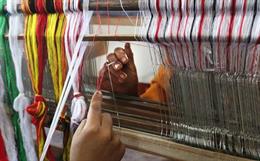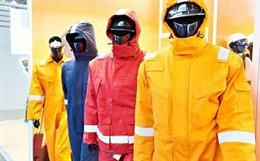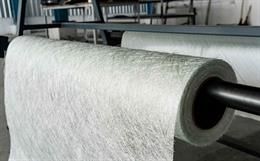Fibers@MIT, a research group at MIT, has developed a digital fibre with artificial intelligence and machine learning capabilities. It could well be setting Moore’s law in motion for computational fabrics. But a lot depends on market acceptability and use-cases for this technology. Let’s have a look at what changes this innovation can bring in e-textiles.
It isn’t new that human beings have been tinkering with naturally occurring materials to produce clothing or wearables. Flax is known to grow naturally in wild, and was domesticated more than 8,000 years ago, while it was being used for its fibre even before that. And the inherent technology to process these fibres into yarn, fabric and garments has not changed substantially, while how we use them has undergone tremendous change over the last century. Traditionally, clothing was only used as protection against our natural surroundings (mostly for temperature regulation) and then more recently for fashion and aesthetics. With almost universal presence of clothing and textiles in our daily lives, it became increasingly more obvious that further opportunities were available to tinker with textile and clothing materials. Blending of different fibres was an early and significant technological change bringing multiple characteristics of different materials into one, however, that didn’t alter the utility of textile materials beyond clothing, industrial use and aesthetics.
While the conventional utility continues to be the most significant, what has transpired over the years in the textile sector, is its conjunction with electronics, chemistry and technology which can make textiles much more dynamic than just blending. The earliest such combinations were made by designers like Diana Dew who were experimenting back in the 1960s with LED lights fitted into clothing, with a battery pack attached to it. While such LED fitted clothes may have become things of the past, the more sophisticated versions available today are luminous fabrics (fibre optic fabric) which can emanate different colours using optic fibres woven into synthetic fibres. While, this has mere aesthetic value, other smart or functional textiles today provide other use-cases as well.
Smart textiles are a much broader term and includes early inventions such as lycra and gore fibres which have much more dynamic characteristics (stain-resistance, anti-microbial, water-resistance, wind-proof, less damage from extreme temperature & UV etc) than conventional clothing. These are called “passive” smart textiles as they provide additional features than traditional textiles but did not alter features in response to changing environmental factors. These were perfected by bringing greater electronics integration into fibre, giving rise to “active smart textiles”. Embedding thermal sensors, circuits and more recently optic fibre into the fabric; lacing fibre with conductive materials meant that the fabric now became electronically charged device but perfectly safe to wear, maintaining the usual characteristics of the material. These active smart textiles can adapt their features with the help of electric sensors and actuators.
The early applications of these were pre-dominantly in sportswear, military and space travel and have now more recently been introduced as clothing in the market. Active smart textiles which could easily be advanced to capture body and health stats of the wearer have tremendous opportunities in the medtech, healthtech and indutech sectors. In addition to maintaining comfortable conditions for the wearer for longer periods of time, clothing made of such materials is now being used for monitoring the wearer’s health and indicate any anomaly to medical practitioners in case of a patient. A simple example of smart textiles in indutech sector is of an industrial rope (a high frequency product). Integrating technology into the rope could indicate the amount of stress on the rope and help prevent damage. Levi’s Trucker jacket in collaboration with Jacquard (Google) brought one such application to the fashion space, but with limited features such as wifi, bluetooth access and able to control digital media.
Common features of this technology are 1) smart materials made of conductive fibres which convert vital signs into electrical signs and 2) electronic devices to record these signals for monitoring and changing the features of the clothing material. Here the fibre inherently remains the same but are only processed with different conducting materials or metallic fibres to become electrically charged. Further development in this happened with the emergence of extremely thin circuits and nano-chips which make the hardware part of the electronic textiles much more conducive to wear.
MIT’s digital fibre – what has changed?
Researchers at the MIT, more specifically at the research group Fibers@MIT, have furthered the experiments with electronic textiles and developed what they call a digital fibre, with capacity to not just store information about the user’s movement and vital signs, but also has machine learning and artificial intelligence capabilities enabling recognition of patterns and anomalies in the user’s health. Primarily, this is an innovation in the functionality of the chips, while how the electronics are embedded in the fibre has seen several experiments in the textile space. The process of fitting multiple electronic devices within a single textile fibre is derived from what is called the “thermal drawing process” in the optical fibre technology. This technology is also very recent in electronics, however the research team at MIT is not the first to use it in textiles. Professor Yoel Fink heads the research group of Fibers@MIT, and hints that this technology could potentially give rise to Moore’s law for computational fabrics, dramatically improving its computation power and cost effectiveness.
The earlier functionalities of just monitoring and recording the user’s vitals may soon become old even before they hit the critical mass commercially. As proffesor Fink expects, greater computing capabilities of this digital fibre could help inform about the wearer’s health problems much faster than now, a vital feature in the post-COVID world. Nothing is more ubiquitous in our lives than textiles, and it has become the go-to material for electronic integration in our day-to-day lives. This field is still experimental and provides immense opportunities into the world of touch-free or remote communication. In its patent application, the technology is termed, not surprisingly, as fibre or fabric computers.
Could we use computational fabrics more widely?
Researchers at Fibers@MIT and many other research labs have been relentlessly perfecting wearable electronics in the form of clothing, but the technology is yet to see much market uptake. One of the primary selling points of this technology is that it doesn’t require an additional device to be worn for the user to be digitally connected. Your jacket could be your phone, your computer and your music player.1 But the fact that other electronic wearables have such a huge market penetration already, the scope for smart textiles as usual wearables can became limited. This was the case with smart textiles for the sports industry, and its unglamorous presence. Another concern with wearable electronic textiles is its washability, as electronic devices could be less wash friendly than the textile fibre it is embedded into.
Therefore, the answer to whether we could be using this technology widely in the future lies in what utility these might be deployed for. Even though the cost of fabric computers becomes commercially viable, its availability for daily use may take longer, except for specific use-cases. Medical, military and space applications have been the frontrunners in using and providing constant feedback into the background research. But for mass-consumption, fabric computers might take long time because of its limited value-addition. Consumers find greater value in other smart textiles such as heated jackets which are fairly simple in design and have a perfectly defined and highly marketable use-case.2 Evidently then, heated clothing make the largest chunk of smart textiles, and as estimated by IDTechEx, smart clothing products for monitoring health metrics constitute only around 10.0 per cent of heated garments market.3
Even if the idea behind computational fabrics is path-breaking and could potentially revolutionise the way we look at clothing, it remains to explain at a mass-scale, why should we. Competing wearable electronics and digital devices makes it tougher for this segment of smart clothing to really get to scale. If not for regular use, this could however, bring sea change in how healthcare integrates into our lives. Without even thinking, we could possibly be conveying our body functions to our doctor. It is worth mentioning again that these could become marketable for very specific use-cases, such as incontinence underwear, but may only remain limited to mitigating health issues. Wearable healthcare devices also have a big market nonetheless (estimated around between $18-20 billion in 2020), and still leaves greater opportunities to explore for this technology.
References:
1.https://www.embs.org/pulse/articles/e-textiles-for-health-monitoring-off-to-a-slow-start-but-coming-soon/
2.https://www.idtechex.com/fr/research-article/updating-the-e-textiles-mantra-an-analysts-commentary/20938
3 See note 2







